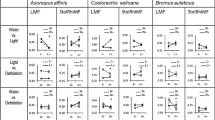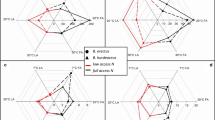Summary
We tested the hypothesis that the amount of compensatory growth after defoliation is affected by the level of stress at which plants grow when defoliated and by the length of time for recovery. Growth response to defoliation went from partial compensation when plants were growing at high relative growth rates (RGR) to overcompensation when plants were more stressed and growing at low RGR. Defoliation released plants from the limitation imposed by the accumulation of old and dead tissue and this release overrode the negative effect of biomass loss. Compensatory growth resulted from a higher RGR aboveground that was not associated with a reduction in RGR belowground. Time available for recovery had a major impact on the outcome of defoliation. With a short time for recovery, RGR was decreased by defoliation because an immediate increase in net assimilation rate was overridden by a reduction in the ratio of leaf area to plant weight. After defoliation, this ratio increased quickly due to a larger allocation to leaf growth and lower leaf specific weights, resulting in higher RGR. We conclude that the compensatory response to grazing depends on the type and level of stress limiting growth. Allocation and physiological responses to stress may positively or negatively affect the response to grazing and, simultaneously, grazing may alleviate or aggravate the effects of different types of stress.
Similar content being viewed by others
References
Alexander KI, Thompson K (1982) The effect of clipping frequency on the competitive interaction between two perennial grass species. Oecologia 53:251–254
Archer SA, Detling JK (1986) Evaluation of potential herbivore mediation of plant water status in a North American mixed-grass prairie. Oikos 47:287–291
Belsky AJ (1986) Does herbivory benefit plants? A review of the evidence. Am Nat 127:870–892
Brown BJ, Allen TFH (1989) The importance of scale in evaluating herbivory impacts Oikos 54:189–194
Bryant JP, Kuropat PJ, Cooper SM, Frisby K, Owen-Smith N (1989) Resource availability hypothesis of plant antiherbivore defence tested in a South African savanna ecosystem. Nature 340:227–229
Caldwell MM, Richards JH, Johnson DA, Nowak RS, Dzurec RS (1981) Coping with herbivory: photosynthetic capacity and resource allocation in two semiarid Agropyron bunchgrasses. Oecologia 50: 14–24
Causton DR, Venus JC (1981) The biometry of plant growth. Edward Arnold, London, pp 307
Chapin FS, McNaughton SJ (1989) Lack of compensatory growth under phosphorus deficiency in grazing-adapted grasses from the Serengeti Plains. Oecologia 79:558–562
Chapin FS, Bloom AJ, Field CB, Waring RH (1987) Plant responses to multiple environmental factors. Bioscience 37:49–57
Coley PD (1987) Interspecific variation in plant anti-herbivore properties: the role of habitat quality and rate of disturbance. New Phytol 106:251–164
Coley PD (1988) Effects of plant growth rate and leaf lifetime on the amount and type of anti-herbivore defense. Oecologia 74:531–537
Coley PD, Bryant JP, Chapin FS (1985) Resource availability and plant antiherbivore defense. Science 230:895–899
Coughenour MB (1985) Graminoid responses to grazing by large herbivores: adaptations, exaptations, and interacting processes. Ann M Bot Gard 72:852–863
Georgiadis NJ, Ruess RW, McNaughton SJ, Western D (1989) Ecological conditions that determine when grazing stimulates grass production. Oecologia 81:316–322
Gifford RM, Jenkins CL (1982) Prospects of applying knowledge of photosynthesis toward improving crop production In: Govindjee (ed) Photosynthesis: Development, Carbon Metabolism, and Plant Productivity Vol. II, Academic Press, New York, pp 419–457
Grime JP, Hunt R (1975) Relative growth-rate: its range and adaptive significance in a local flora. J Ecol 63:393–422
Hilbert DW, Swift DM, Detling JK, Dyer MI (1981) Relative growth rates and the grazing optimization hypothesis. Oecologia 51:14–18
Hodgkinson KC, Smith NG, Miles GE (1976) The effects of frequency and extent of defoliation, summer irrigation, and fertilizer on the production and survival of the grass Danthonia caespitosa Gaud. Aust J Agric Res 27:755–767
Hunt R (1982) Plant growth curves. The functional approach to growth analysis. Univ. Park, Baltimore, pp 248
Hunt R, Nicholls AO (1986) Stress and the coarse control of growth and root-shoot partitioning in herbaceous plants. Oikos 47:149–158
Jackson MB, Drew MC (1984) Effects of flooding on growth and metabolism of herbaceous plants. In: Kozlowski TT (ed) Flooding and Plant Growth, Academic Press, Orlando, pp 47–128
Leon RJC, Rusch GM, Oesterheld M (1984) Pastizales pampeanosimpacto agropecuario. Phytocoenologia 12:201–218
Malechek JC, Balph DF (1987) Diet selection by grazing and browsing livestock In: Hacker JB, Ternouth JH (eds) The Nutrition of Herbivores, Academic Press, Sydney, pp 121–132
Maschinski J, Whitham TG (1989) The continuum of plant responses to herbivory: the influence of plant association, nutrient availability, and timing. Am Nat 134:1–19
McNaughton SJ (1979) Grazing as an optimization process: grassungulate relationships in the Serengeti. Am Nat 113:691–703
McNaughton SJ (1983) Compensatory plant growth as a response to herbivory. Oikos 40:329–336
McNaughton SJ (1984) Grazing lawns: animals in herds, plant form, and coevolution. Am Nat 124:863–886
McNaughton SJ (1985) Ecology of a grazing ecosystem: The Serengeti. Ecol Monogr 55:259–294
McNaughton SJ, Chapin FS (1985) Effects of phosphorus nutrition and defoliation on C4 graminoids from the Serengeti plains. Ecology 66: 1617–1629
Milchunas DG, Lauenroth WK (1989) 3-Dimensional distribution of plant biomass in relation to grazing and topography in the shortgrass prairie. Oikos 55:82–86
Milchunas DG, Sala OE, Lauenroth WK (1988) A generalized model of the effects of grazing by large herbivores on grassland community structure. Am Nat 132:87–106
Oesterheld M, McNaughton SJ (1988) Intraspecific variation in the response of Themeda triandra to defoliation. The effect of time of recovery and growth rates on compensatory growth. Oecologia 77:181–186
Olson BE, Senft RL, Richards JH (1989) A test of grazing compensation and optimization of crested wheatgrass using a simulation model. J Range Manage 42:458–467
Polley HW, Detling JK (1988) Herbivory tolerance of Agropyron smithii populations with different grazing histories. Oecologia 77: 261–268
Sala OE, Deregibus VA, Schlichter TM, Alippe HA, (1981) Productivity dynamics of a native temperature grassland in Argentina. J Range Manage 34: 48–51
Sala OE, Oesterheld M, Leon RJC, Soriano A (1986) Grazing effects upon plant community structure in subhumid grasslands of Argentina. Vegetatio 67:27–32
Sims PL, Singh JS (1978a) The structure and function of ten western North American grasslands. II. Intra-seasonal dynamics in primary producer compartments. J Ecol 66:547–572
Sims PL, Singh JS (1978b) The structure and function of ten western North American grasslands. III. Net primary production, turnover and efficiencies of energy capture and water use. J Ecol 66:573–597
Toft NL, McNaughton SJ, Georgiadis NJ (1987) Effects of water stress and simulated grazing on leaf elongation and water relations of an east African grass, Eustachys paspaloides. Aust J Plant Physiol 14:211–226
van der Maarel E, Titlyanova A (1989) Above-ground and below-ground biomass relations in steppes under different grazing conditions. Oikos 56:364–370
Verkaar HJ, Van der Meijden E, Breebaart L (1986) The responses of Cynoglossum officinale L. and Verbascum thapsus L. to defoliation in relation to nitrogen supply. New Phytol 104:121–129
Williamson SC, Detling JK, Dodd JL, Dyer MI (1989) Experimental evaluation of the grazing optimization hypothesis. J Range Manage 42:149–152
Author information
Authors and Affiliations
Rights and permissions
About this article
Cite this article
Oesterheld, M., McNaughton, S.J. Effect of stress and time for recovery on the amount of compensatory growth after grazing. Oecologia 85, 305–313 (1991). https://doi.org/10.1007/BF00320604
Received:
Accepted:
Issue Date:
DOI: https://doi.org/10.1007/BF00320604




